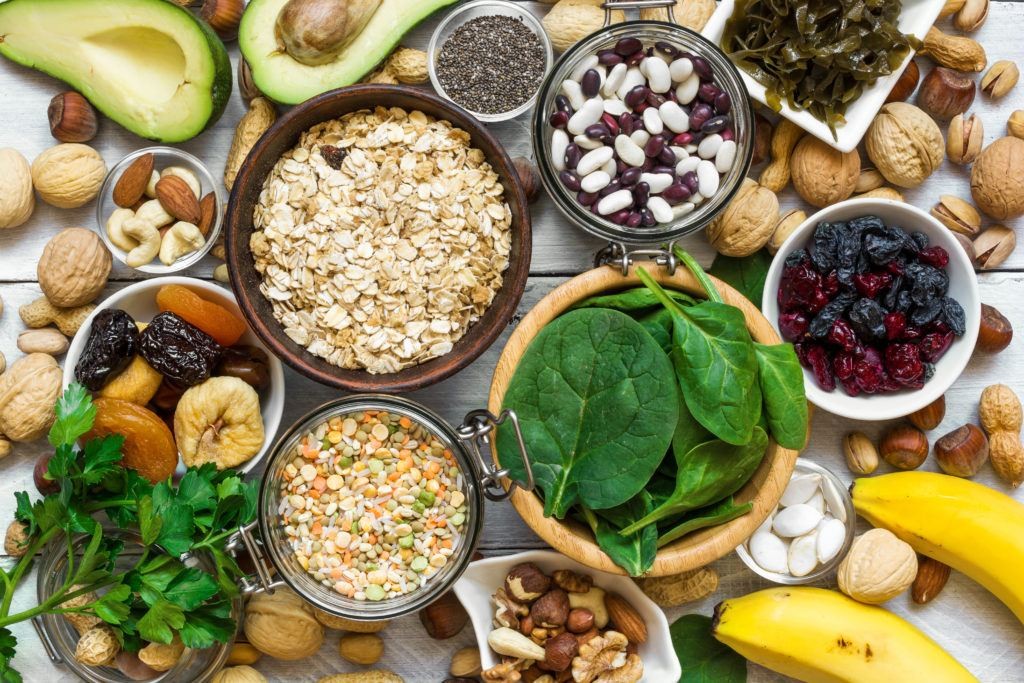Magnesium is a vital mineral that plays a critical role in maintaining overall health. It’s involved in over 300 enzymatic reactions in the body, contributing to everything from protein synthesis and bone strength to blood sugar regulation and nerve function. Ensuring you get enough magnesium through your diet is crucial for optimal well-being. This guide will explore the best Sources Of Magnesium In Foods, helping you to incorporate this essential nutrient into your daily meals.
 Variety of magnesium-rich foods including nuts, seeds, leafy greens, fruits, and grains, highlighting natural sources of magnesium for a healthy diet.
Variety of magnesium-rich foods including nuts, seeds, leafy greens, fruits, and grains, highlighting natural sources of magnesium for a healthy diet.
Understanding Magnesium and Its Role in Your Body
Magnesium is more than just a mineral; it’s a powerhouse nutrient. It functions as an electrolyte, helping to conduct electrical signals in the body, which is essential for muscle contractions, including keeping your heartbeat steady. Beyond this, magnesium is fundamental for:
- Building and Maintaining Strong Bones: A significant portion of the body’s magnesium is stored in bones, contributing to their structure and strength. It also plays a role in the activity of osteoblasts and osteoclasts, the cells responsible for bone building and breakdown.
- Regulating Blood Sugar Levels: Magnesium is involved in insulin sensitivity and glucose metabolism. Adequate intake can help manage blood sugar levels and reduce the risk of type 2 diabetes.
- Supporting Healthy Blood Pressure: Magnesium aids in vasodilation, helping blood vessels to relax, which in turn contributes to maintaining healthy blood pressure levels.
- Nerve and Muscle Function: Magnesium is crucial for nerve signal transmission and muscle contraction. It helps muscles relax after contraction and is vital for preventing cramps and spasms.
- Protein Synthesis: Magnesium is needed for the body to build proteins, essential components for cell structure, enzymes, and hormones.
Recommended Daily Intake of Magnesium
The amount of magnesium you need daily varies based on age and sex. The Recommended Dietary Allowance (RDA) for magnesium for adults aged 19-51+ is:
- Men: 400-420 mg daily
- Women: 310-320 mg daily
During pregnancy, the requirement increases to about 350-360 mg daily, and during lactation, it’s slightly lower at 310-320 mg daily.
It’s also important to be aware of the Tolerable Upper Intake Level (UL) for magnesium, which is 350 mg per day from supplements. This upper limit is set for supplemental magnesium because excessive intake from supplements can sometimes lead to side effects like diarrhea, nausea, and abdominal cramps. However, it’s worth noting that you can’t get too much magnesium from food sources alone, as your kidneys will efficiently eliminate any excess magnesium through urine.
Top Food Sources of Magnesium
Fortunately, magnesium is widely available in a variety of foods, making it easy to incorporate into your diet. Here are some of the best sources of magnesium in foods:
Nuts and Seeds: Nutrient-Packed Powerhouses
Nuts and seeds are excellent sources of magnesium, along with healthy fats, fiber, and other essential nutrients.
- Pumpkin Seeds: These are among the top contenders for magnesium-rich seeds. Just one ounce (approximately 28 grams) of pumpkin seeds provides a significant amount of magnesium, around 156 mg, which is about 37% of the RDA for women. They are also a great source of zinc and iron.
- Chia Seeds: While often touted for their omega-3 fatty acids and fiber, chia seeds are also a good source of magnesium. Two tablespoons of chia seeds offer about 95 mg of magnesium, contributing to around 30% of the RDA for women.
- Almonds: Almonds are a popular and versatile nut that is rich in magnesium. A one-ounce serving of almonds contains approximately 76 mg of magnesium, or about 24% of the RDA for women. They are also a good source of vitamin E and healthy monounsaturated fats.
- Cashews: Cashews are another delicious and magnesium-rich nut. An ounce of cashews delivers around 73 mg of magnesium, roughly 23% of the RDA for women. They also provide iron and zinc.
- Peanuts: Technically legumes but often categorized with nuts, peanuts are a readily available and affordable source of magnesium. One ounce of peanuts provides about 49 mg of magnesium, around 15% of the RDA for women. Peanut butter is also a convenient way to get magnesium, but be mindful of added sugars and sodium.
- Walnuts: Walnuts are known for their heart-healthy omega-3 fatty acids, but they also contribute to your magnesium intake. An ounce of walnuts offers about 45 mg of magnesium, approximately 14% of the RDA for women.
- Hazelnuts: Hazelnuts are another tasty nut option that provides magnesium. An ounce of hazelnuts contains around 45 mg of magnesium, similar to walnuts.
Legumes: Versatile and Magnesium-Rich
Legumes, including beans, lentils, and soybeans, are not only excellent sources of plant-based protein and fiber but also contribute significantly to your magnesium intake.
- Black Beans: Black beans are a versatile and widely available legume that is high in magnesium. One cup of cooked black beans provides an impressive 120 mg of magnesium, about 37% of the RDA for women. They are also packed with fiber and protein.
- Kidney Beans: Kidney beans are another great choice in the bean family for magnesium. One cup of cooked kidney beans offers around 70 mg of magnesium, about 22% of the RDA for women. They are also rich in iron and folate.
- Lentils: Lentils are quick-cooking and nutrient-dense legumes that are good sources of magnesium. One cup of cooked lentils provides approximately 36 mg of magnesium, around 11% of the RDA for women. They are also excellent sources of iron and protein.
- Soybeans and Soymilk: Soy products, including soybeans, edamame, tofu, and soymilk, are good plant-based sources of magnesium. One cup of cooked soybeans offers a substantial 98 mg of magnesium, about 30% of the RDA for women. Soymilk is also a source, with about 61 mg of magnesium per cup.
Whole Grains: More Than Just Fiber
While often recognized for their fiber content, whole grains also provide a range of minerals, including magnesium.
- Oats and Oatmeal: Oats, especially whole oats and oatmeal, are a good way to start your day with a boost of magnesium. One cup of cooked oatmeal provides around 36 mg of magnesium, about 11% of the RDA for women. Choose whole oats or steel-cut oats for the most nutritional benefits.
- Brown Rice: Brown rice is a nutritious alternative to white rice, offering more fiber and magnesium. One cup of cooked brown rice contains approximately 42 mg of magnesium, around 13% of the RDA for women.
Leafy Green Vegetables: Nutrient-Dense Greens
Dark leafy green vegetables are nutritional powerhouses, loaded with vitamins, minerals, and antioxidants, including magnesium.
- Spinach: Spinach is a top leafy green choice for magnesium. One cup of cooked spinach provides a remarkable 157 mg of magnesium, nearly half of the RDA for women. Spinach is also rich in iron, calcium, and vitamin K.
- Swiss Chard: Swiss chard is another excellent leafy green source of magnesium. One cup of cooked Swiss chard offers about 150 mg of magnesium, similar to spinach. It’s also a good source of vitamins A, C, and K.
Fruits: Sweet and Subtle Sources
While fruits may not be as concentrated in magnesium as nuts, seeds, or leafy greens, some fruits do contribute to your daily intake.
- Bananas: Bananas are a convenient and potassium-rich fruit that also contains magnesium. One medium banana provides about 32 mg of magnesium, around 10% of the RDA for women.
- Avocados: Avocados are creamy and nutrient-dense fruits that offer healthy fats and magnesium. One avocado provides approximately 58 mg of magnesium, about 18% of the RDA for women.
- Dried Apricots: Dried apricots are a sweet and chewy snack that can contribute to your magnesium intake. A half-cup serving of dried apricots offers about 34 mg of magnesium, around 10% of the RDA for women.
Other Notable Sources
Beyond these main categories, other foods can contribute to your magnesium intake.
- Dark Chocolate: For chocolate lovers, dark chocolate (at least 70% cocoa) can be a surprisingly good source of magnesium. A one-ounce serving of dark chocolate can provide around 65 mg of magnesium, about 20% of the RDA for women. It also offers antioxidants and other beneficial compounds.
- Dairy Products: Milk and yogurt provide modest amounts of magnesium, along with calcium and vitamin D. One cup of milk contains about 24-39 mg of magnesium, while yogurt can have similar amounts.
- Fatty Fish: Fish like salmon are not only rich in omega-3 fatty acids but also contain magnesium. A 3-ounce serving of salmon provides about 26 mg of magnesium.
- Beef and Poultry: Meat, including beef and poultry, contains magnesium, although in lesser amounts compared to plant-based sources.
Tips to Increase Magnesium Intake Through Food
Incorporating more sources of magnesium in foods into your diet is easier than you might think. Here are a few practical tips:
- Snack Smart: Swap processed snacks for nuts and seeds. Keep a jar of mixed nuts or pumpkin seeds handy for a quick and nutritious snack.
- Go Green: Add leafy greens like spinach or Swiss chard to your meals. Sauté spinach as a side dish, add it to smoothies, or include chard in soups and stews.
- Choose Whole Grains: Opt for whole grains like brown rice and oatmeal over refined grains. Start your day with oatmeal or use brown rice in stir-fries and bowls.
- Legume Love: Incorporate legumes into your weekly meals. Add beans to salads, make lentil soup, or enjoy tofu or edamame.
- Dark Chocolate Treat: Enjoy a small square of dark chocolate as a dessert or afternoon treat.
- Avocado Addition: Add avocado slices to sandwiches, salads, or toast.
- Banana Boost: Have a banana as a quick breakfast or snack.
When to Consider Magnesium Supplements
While obtaining magnesium from food is always the preferred method, supplements might be considered in certain situations. If you suspect you have a magnesium deficiency or have difficulty meeting your needs through diet alone, consult with a healthcare professional. They can assess your individual needs and advise on whether supplementation is necessary and the appropriate dosage and form.
Magnesium supplements are available in various forms, such as magnesium citrate, magnesium oxide, and magnesium chloride. Liquid forms like magnesium citrate or chloride are often considered to be better absorbed than solid tablets like magnesium oxide.
It’s important to remember that high doses of magnesium supplements can cause side effects. Always adhere to recommended dosages and consult with a healthcare provider before starting any new supplement regimen, especially if you have underlying health conditions or are taking other medications.
Conclusion
Magnesium is an essential mineral that plays a multitude of roles in maintaining good health. By focusing on incorporating a variety of sources of magnesium in foods into your daily diet, you can ensure you are meeting your nutritional needs naturally and effectively. Nuts, seeds, legumes, whole grains, and leafy green vegetables are just some of the delicious and versatile options available. Embrace these magnesium-rich foods to support your overall well-being and enjoy a healthier, more balanced diet.
References
Last reviewed March 2023
Terms of Use
The contents of this website are for educational purposes and are not intended to offer personal medical advice. You should seek the advice of your physician or other qualified health provider with any questions you may have regarding a medical condition. Never disregard professional medical advice or delay in seeking it because of something you have read on this website. The Nutrition Source does not recommend or endorse any products.
